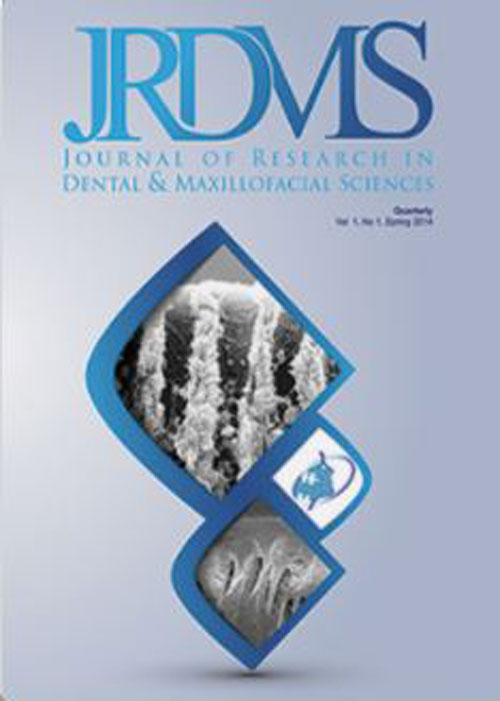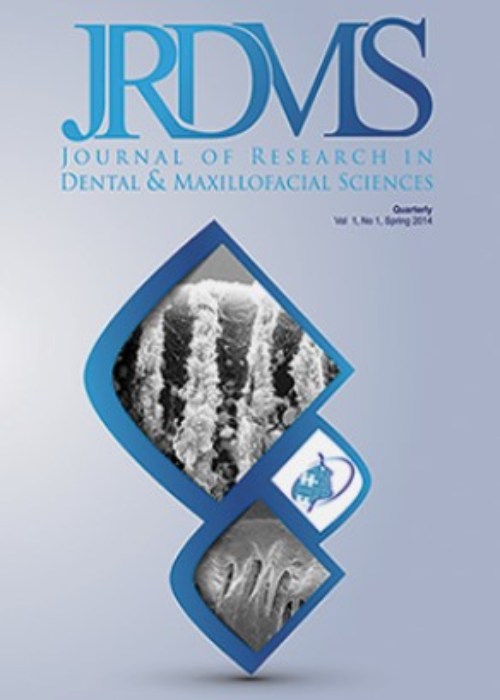فهرست مطالب

Journal of Research in Dental and Maxillofacial Sciences
Volume:7 Issue: 1, Winter 2022
- تاریخ انتشار: 1400/10/22
- تعداد عناوین: 8
-
-
Pages 1-8Background and Aim
This study aimed to provide an overview about the efficacy of photodynamic therapy (PDT) as an adjunct to scaling and root planing (SRP) versus SRP alone in non-surgical periodontal therapy.
Materials and MethodsRandomized clinical trials (RCTs) with a minimum duration of 3 months, evaluating PDT+SRP versus SRP alone in non-surgical periodontal treatment of patients diagnosed with aggressive or chronic periodontitis who had at least 2 teeth with probing depth (PD) ≥4 mm, and in vitro studies evaluating the effect of adjunctive PDT on proliferation or viability of human gingival fibroblasts (HGFs) were included. An electronic search of the literature was carried out mainly through PubMed, Cochrane Library, and Google scholar for relevant English articles published from January 2011 to January 2021 using the following keywords: "photodynamic therapy" and “periodontitis" or “periodontal diseases”.
ResultsTwelve articles were reviewed in this study. Analysis of the clinical attachment level (CAL), PD, gingival index (GI), plaque index (PI), bleeding on probing (BOP) and microbiological counts of Aggregatibacter actinomycetemcomitans (A. actinomycetemcomitans) and Porphyromonas gingivalis (P. gingivalis) demonstrated variable outcomes. Five articles revealed significant improvement of clinical parameters in the PDT groups compared with the control group (P<0.05); five studies reported significant improvement of CAL (P<0.05). However, three studies found no significant difference between PDT and control groups in terms of CAL (P>0.05).
ConclusionPDT+SRP could help improve the periodontal parameters, compared with SRP alone. Further studies are required to reach a stronger conclusion regarding the superiority of one over the other.
Keywords: Photochemotherapy, Root Planing, Periodontitis -
Pages 8-14Background and objectives
Gingivitis is the most common gingival inflammatory disease. Plaque control methods play a major role in the prevention of periodontal disease and dental caries, which include mechanical and chemical technique. The present study was conducted to investigate the effect of chewing gum on dental plaque on smooth teeth surface.
MethodsA cross-over clinical trial was conducted on 18 subjects. The study was conducted in two 2-day duration with a 4-day wash out period. At the beginning of the study, subjects received professional prophylaxis. During the study period, they refused to brush and floss. Volunteers in the test group were instructed to chew one pellet four times a day for 20 min. On the third day, O'Leary and the Bleeding Point Index were measured. In the second stage, two groups were displaced. Finally, the data were subjected to statistical analysis by paired t-test and Wilcoxon.
ResultsThere was no significant reduction in plaque and bleeding index in test group (P =0.187) compared to control group.
ConclusionIn the absence of oral health procedure, chewing gum has no significant effect on plaque reduction in the smooth teeth surface.
Keywords: Chewing gum, plaque Index, Gingivitis -
Pages 15-21Background and Aim
The purpose of this study was to compare dentinal tubular penetration of two root canal sealers namely AH26 and MTA Fillapex in single-rooted teeth by scanning electron
microscopy.Materials and MethodsThirty-five mature human single-rooted teeth were selected. Cleaning and shaping was performed. The teeth were randomly divided into 2 groups. AH26 was delivered into the canals in group 1, and MTA Fillapex was delivered into the root canals in group 2 by lateral compaction technique. The roots were sectioned at 3 mm and 5 mm from the apex. The sections were evaluated by scanning electron microscopy, and the deepest penetration depth of sealers was recorded. Statistical analysis was performed by t-test using SPSS version 19.0.
ResultsThe deepest tubular penetration in group 1 at 3 mm from the apex was 808 µm while it was 717 µm in group 2 at 3 mm from the apex. The difference between the two groups was not significant (P=0.4). At 5 mm from the apex, the deepest tubular infiltration in group 1 was 995 µm while it was 915 µm in group 2. The difference between the 2 groups was not significant (P=0.4).
ConclusionBoth sealers can be predictively used in different clinical situations when indicated .
Keywords: Root Canal Preparation, Microscopy, Electron, Scanning, Root Canal Therapy -
Pages 22-27Background and Aim
Dental treatments may have adverse effects on patients with a previous history of coronary heart disease and lead to cardiac complications. Different biomarkers have been investigated to assess the relationship between dental treatments and cardiovascular complications. The present study was conducted to evaluate the troponin changes before and after dental surgery in patients with a history of ischemic heart disease.
Materials and MethodsThis cross-sectional study was conducted on 25 patients referred for dental surgery with a history of ischemic heart disease. The patients' demographic information including their age and gender was collected, and serum levels of troponin were measured before surgery and at 4 hours after surgery, and the results were compared. The study data were entered into SPSS version 23 and analyzed by the Student t-test and McNemar test.
ResultsIn the present study, 25 patients including 11 males and 14 females with a mean age of 44.78 years were evaluated. The mean level of troponin was 8.01±5.94 before surgery and 6.16±4.84 after surgery. Statistically, no significant difference was found
between troponin levels before and after surgery in patients (P=0.274).Conclusionbased on the results of the present study, no significant change was noted in troponin levels of patients with a previous history of ischemic heart disease at 4 hours after dental surgery.
Keywords: Dentistry, Myocardial Ischemia, Troponin -
Pages 28-34Background and Aim
Assessing the common oral lesions and their prevalence is important in different populations. This study assessed the prevalence of oral vascular lesions in patients referred to the Oral Medicine Department of Shiraz Dental School.
Materials and MethodsIn this cross-sectional study which was conducted in Shiraz Dental School, records of patients admitted from 2001 to 2017 were reviewed. A total of 176 patients had been diagnosed with oral vascular lesions. The mean age and gender of patients and the prevalence of vascular lesions were recorded and analyzed. Associations between the variables were explored using the Chi-square test and Kruskal-Wallis test. P<0.05 was considered statistically significant.
ResultsA total of 176 patients had oral vascular lesions among 3,896 clinical patient records during the 16-year period (2001-2017). Of the 176 patients, 108 (61.4%) were females and 68 (38.6%) were males. The mean age at presentation was 36 ±4.5 years with an overall age range of 4-88 years. Amongst all the evaluated oral lesions, the most prevalent vascular lesion was pyogenic granuloma with 124 (3.18%) patients. Other vascular lesions were vascular malformations (n=27, 0.7%), hemangioma (n=19, 0.49%), and lymphangioma (n=6, 0.15%). There was no significant correlation between gender with vascular lesions (P=0.078) or location of lesions (P=0.143). No significant correlation was found between age with type of vascular lesion (P=0.174) or site of involvement (P=0.281).
ConclusionAmong oral vascular lesions, pyogenic granuloma was found to be the most prevalent lesion in the oral cavity.
Keywords: Lymphangioma, Granuloma, Pyogenic, Hemangioma, Vascular Malformations -
Pages 35-40Objectives
This study aimed to evaluate the relationship of diabetes mellitus (DM) and trigeminal neuralgia (TN) in order to provide new insight for TN pathogenesis.
Materials and MethodsThis retrospective cross-sectional study compared the prevalence of DM in patients with TN and healthy controls without TN during 2007-2018. Totally, 193 participants were enrolled in the patient and control groups. These participants were selected among patients referred to the Oral and Maxillofacial Medicine Department of Dental School of Shiraz University of Medical Sciences. The age and gender of patients were matched in the two groups. DM (types 1 and 2) was diagnosed based on patient reports and routinely requested lab tests (fasting blood sugar, 2-hour post-prandial). The odds ratio (OR) and Chi-square test were used to compare the mean values.
ResultsThe prevalence of DM in TN patients and control group was 11.4% and 9.8%, respectively. The mean age of the participants was 56.96±13.66 and 56.46±13.47 years in the TN and control groups, respectively. The difference in TN prevalence between the two groups was not significant (P=0.62).
ConclusionAlthough the prevalence of DM in patients with TN was higher than the control group, this difference was not significant (P>0.05). Women with TN showed DM 25% more than men with TN.
Keywords: Trigeminal Neuralgia, Diabetes Mellitus, Pain -
Pages 41-47Introduction
Decontamination of gutta-percha (GP) cones is recommended before placement in the root canal system. However, the incidence of contamination is still a matter of debate. The present study aimed to evaluate the contamination of GP cones before and during clinical use by general dentists.
Materials and MethodsIn this in vitro study, 120 GP cones (#20) were examined for incidence of contamination. First, 30 GP packages were opened under aseptic laboratory conditions, and two cones were randomly selected for the laboratory tests. Next, the initially sampled packages were distributed among 30 general dentists and then they were asked to use them clinically for 7 days and then the packages were collected for the microbial tests. The collected cones were placed in tubes containing thioglycolate medium and incubated at 37℃ for 21 days. Bacterial growth was detected by presence of turbidity and comparison with the control groups. A sample was collected from the tubes showing turbidity and plated in blood agar and also underwent Gram-staining, followed by colony counting. Data were analyzed using the Chi-square and paired sample t-test (alpha=0.05).
ResultsNone of the 60 samples from initial sampling of packages showed contamination. However, in secondary sampling after clinical use, 8.3% of GP samples were positive for contamination. There was a statistically significant difference in contamination of packages before and after clinical use (P= 0.02).
ConclusionWithin the limitations of this study, it can be concluded that GP cones can become infected after opening the package and in the process of clinical use.
Keywords: Root Canal Therapy, Disinfection, Gutta-Percha, Sterilization -
Pages 48-54Background and Aim
Despite the advantages and conveniences that NiTi files offer, their main drawback is their catastrophic fracture due to cyclic and torsional fatigue leading to instrument separation. This study aimed to compare the cyclic fatigue resistance of two single file engine-driven instruments, HyFlex EDM and NeoNiTi A1, in simulated curved canals.
Materials and MethodsIn this experimental study, NiTi endodontic instruments with a similar tip size of 0.25 mm were investigated in two groups of 20: HyFlex EDM (group A) and Neoniti A1 (group B). Evaluation of cyclic fatigue was conducted in a stainless steel artificial canal with a 60° angle and 5-mm radius curvature. HyFlex EDM and Neoniti A1 instruments were operated based on the instruction for use provided by the manufacturers. All instruments were rotated (at 400 rpm) until fracture, and the number of cycles to fracture (NCF) and the length of the fractured tip were documented. Means and standard deviations of NCF and fragment length were determined for each system and compared using the Mann-Whitney test (P<0.05).
ResultsA statistically significant difference was detected when comparing the NCF, and time until fracture of HyFlex EDM and Neoniti A1 instruments (P=0.001). HyFlex EDM instruments showed significantly greater mean NCF in comparison with Neoniti A1 instruments (2984.75 ± 576.14 vs. 839.55 ± 305.5 NCF). No statistically significant difference was found in the mean length of the fractured fragments between the instruments (P=0.683).
ConclusionHyFlex EDM instruments showed significantly greater cyclic fatigue resistance compared with Neoniti A1 instruments.
Keywords: Fatigue, Root Canal Therapy, Stainless Steel


